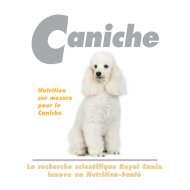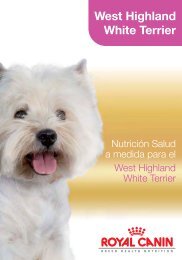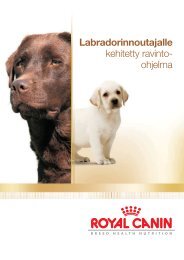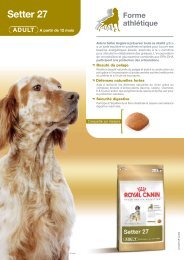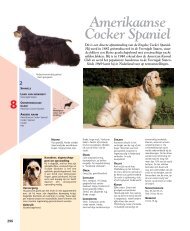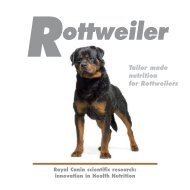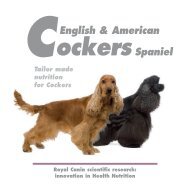The Great Dane - Breed Nutrition - Royal Canin
The Great Dane - Breed Nutrition - Royal Canin
The Great Dane - Breed Nutrition - Royal Canin
Create successful ePaper yourself
Turn your PDF publications into a flip-book with our unique Google optimized e-Paper software.
Hypertrophic osteodystrophy<br />
This disease is characterised by major changes to the bone tissue, resulting in excessive bone production.<br />
Lameness is generally bilateral (front or back) and tumours at the extremities of the long<br />
bones may be observed. Male puppies are more at risk than females.<br />
<strong>The</strong> bones most affected are in the forelegs (radius, ulna) and the tibia (sometimes even the mandible).<br />
Local inflammation is accompanied by bouts of fever and pain in the dog, which refuses to<br />
eat and generally presents signs of intense exhaustion. Although the cause remains unclear, being<br />
overweight and too high a calcium and vitamin D intake are factors that predispose to the appearance<br />
of the disease (Hedhammar et al, 1974).<br />
Whilst the precise cause of hypertrophic<br />
osteodystropy is unknown, excessive<br />
weight during growth is a risk factor,<br />
as is excessive supplementation of<br />
minerals and vitamin D.<br />
Enlargement and increased density<br />
of bone extremities: images of<br />
bone deformity.<br />
Radiolucent and irregular area<br />
parallel to the epiphyseal cartilage.<br />
Hypertrophic osteodystrophy<br />
16<br />
© École Nationale Vétérinaire de Nantes<br />
Osteochondritis<br />
Osteochondritis of the shoulder<br />
Osteochondritis begins with a fissure on the surface of the joint<br />
cartilage. Under the influence of intense activity or excess weight,<br />
a flap of cartilage may become detached and float in the joint.<br />
This is called a joint mouse.<br />
Some breeds that experience rapid growth, such as the <strong>Great</strong> <strong>Dane</strong>, may develop ossification problems<br />
that can lead to malformation of joint cartilage or abnormal growth. <strong>The</strong> most affected joints,<br />
in descending order, are the hocks, the elbows and the shoulders (in most cases both shoulders are<br />
affected). While lameness will most often be unilateral, the disease is frequently bilateral.<br />
Osteochondritis is more often observed in males than females. It is one of the most common causes<br />
of secondary arthritis in dogs. An excess of calcium in the food is a predisposing cause of osteochondritis<br />
(Hazewinkel et al, 1985).<br />
17<br />
1. Scapula (shoulder blade)<br />
2. Head of the humerus<br />
3. Joint mouse<br />
4. cartilage lesion



